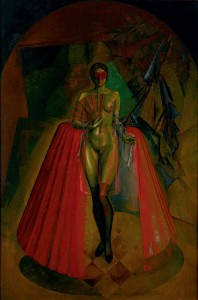Art in Russia during the 1920s and 1930s must be studied, as a rule, in light of the cultural process known as the Russian avant-garde, which had its start in 1910. This leftish art form entered into a short period of collaboration with the newly-formed Soviet state in 1918, when avant-garde artists were asked to put into effect the state’s project of new cultural politics. At the time, the avant-garde movement had not yet been forced to compromise its values in order to please the government, and still harbored the illusion that their ideals would coincide with those of the state.
The innovative art movement initiated the formation of a number of a new educational and research programs and establishments, including: the Russian Academy of Art Studies (RAKhN), the Institute of Art Culture (INKhUK), and the Museum of Painting Culture, which housed a collection of works by left-leaning Russian artists. A system for training young artists, the renowned Higher Art and Technical Studios (Vkhutemas), was also organized at that time.
Contemporaries who witnessed this process interpreted these events as a momentous change that raised the status of art in society to a higher level. The well-known historian and art critic Alexander Gabrichevsky wrote the following in the early 1920s article “Recent Scholarship concerning Art”: “In the era of formalism, the object of study itself, i.e., art in all of its originality, is seen in the scholarly mindset as a peculiar realm of reality and a special type of human creativity.” [1]
This “peculiar realm of reality” is also singled out by Osip Mandelstam in article “Word and Culture”: “The most significant event stemming from our revolution is the separation of culture from the state. The process of secularizing the state did not stop with the separation of the Church from the state, as it was seen by the French Revolution. The social revolution brought with it an even greater secularization. The state today looks at the realm of culture with the particular attitude that is best described by the term “tolerance”… The fact that the state is outside of the boundaries of cultural values makes it completely dependant on culture.” [2]



